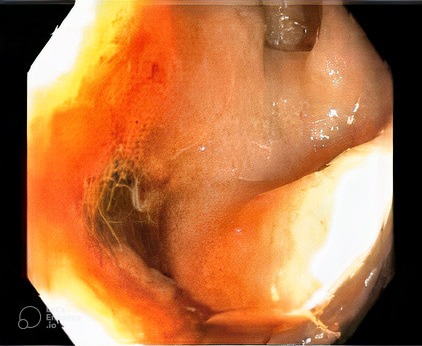Back
Poster Session C - Monday Afternoon
C0351 - Hark the Herald Bleed
Monday, October 24, 2022
3:00 PM – 5:00 PM ET
Location: Crown Ballroom
- NG
Nathan Grigg, DO
Parkview Medical Center
Pueblo, CO
Presenting Author(s)
Nathan Grigg, DO, Bryant Javier, DO, Amanda Sullivan, DO, Manaquibb Khan, MD, Daniel Heck, DO, Renuka Singh, MD, Jimmy Giang, DO
Parkview Medical Center, Pueblo, CO
Introduction: An Aortoenteric fistula (AEF) is a rare, life-threatening condition with a reported incidence of 0.007 per million (with 250 cases reported in the literature). These fistulae present with what has been coined a “Herald Bleed,” indicating that a benign presentation of Gastrointestinal hemorrhage will likely be followed by catastrophic bleeding. Secondary AEF, more common than primary or denovo fistulae, is the development of a fistula after abdominal aortic aneurysm (AAA) repair. As expected, most fistulae are found in the duodenum due to the anatomical proximity of prior AAA procedures. On occasion, endoscopic confirmation of an AEF is requested, presenting an added risk to a condition with a mortality rate above 45% in the first month.
Case Description/Methods: A 70-year-old female with a pertinent past medical history of antiphospholipid syndrome, seven prior strokes, and known iron deficiency anemia with hematochezia presented to the emergency department with altered mental status. The patient required several units of blood, thus GI was consulted for further evaluation and planned for endoscopy and colonoscopy. Unfortunately, the patient was unable to tolerate bowel preparation and, in the meantime, developed severe sepsis secondary to an infected aortoiliac bypass graft with a likely fistulous communication between the right limb of the bypass graft and inflamed loop of the small bowel as seen on Computed tomography. Vascular surgery was consulted and requested endoscopic confirmation of the AEF prior to surgical intervention. The aortic graft was seen, via endoscopy, with stigmata of bleeding between the second and third part of the duodenum. The patient then had multiple discussions with her multidisciplinary team and family but ultimately decided not to pursue surgical repair due to mortality risk. She elected for comfort care, was discharged home, and passed within weeks.
Discussion: AEF is an incredibly rare condition with a significant mortality rate. Our patient was able to undergo endoscopy and receive diagnostic confirmation. This provided her with the necessary information to decide on further treatment. Diagnosis of AEF remains difficult due to its rarity and we hope that greater awareness of this devastating disease will result in further guidelines concerning diagnosis, management, and improved outcomes.

Disclosures:
Nathan Grigg, DO, Bryant Javier, DO, Amanda Sullivan, DO, Manaquibb Khan, MD, Daniel Heck, DO, Renuka Singh, MD, Jimmy Giang, DO. C0351 - Hark the Herald Bleed, ACG 2022 Annual Scientific Meeting Abstracts. Charlotte, NC: American College of Gastroenterology.
Parkview Medical Center, Pueblo, CO
Introduction: An Aortoenteric fistula (AEF) is a rare, life-threatening condition with a reported incidence of 0.007 per million (with 250 cases reported in the literature). These fistulae present with what has been coined a “Herald Bleed,” indicating that a benign presentation of Gastrointestinal hemorrhage will likely be followed by catastrophic bleeding. Secondary AEF, more common than primary or denovo fistulae, is the development of a fistula after abdominal aortic aneurysm (AAA) repair. As expected, most fistulae are found in the duodenum due to the anatomical proximity of prior AAA procedures. On occasion, endoscopic confirmation of an AEF is requested, presenting an added risk to a condition with a mortality rate above 45% in the first month.
Case Description/Methods: A 70-year-old female with a pertinent past medical history of antiphospholipid syndrome, seven prior strokes, and known iron deficiency anemia with hematochezia presented to the emergency department with altered mental status. The patient required several units of blood, thus GI was consulted for further evaluation and planned for endoscopy and colonoscopy. Unfortunately, the patient was unable to tolerate bowel preparation and, in the meantime, developed severe sepsis secondary to an infected aortoiliac bypass graft with a likely fistulous communication between the right limb of the bypass graft and inflamed loop of the small bowel as seen on Computed tomography. Vascular surgery was consulted and requested endoscopic confirmation of the AEF prior to surgical intervention. The aortic graft was seen, via endoscopy, with stigmata of bleeding between the second and third part of the duodenum. The patient then had multiple discussions with her multidisciplinary team and family but ultimately decided not to pursue surgical repair due to mortality risk. She elected for comfort care, was discharged home, and passed within weeks.
Discussion: AEF is an incredibly rare condition with a significant mortality rate. Our patient was able to undergo endoscopy and receive diagnostic confirmation. This provided her with the necessary information to decide on further treatment. Diagnosis of AEF remains difficult due to its rarity and we hope that greater awareness of this devastating disease will result in further guidelines concerning diagnosis, management, and improved outcomes.

Figure: Endoscopic image demonstrating the source of Gastrointestinal bleed and Aortic graft visualized in the Duodenum.
Disclosures:
Nathan Grigg indicated no relevant financial relationships.
Bryant Javier indicated no relevant financial relationships.
Amanda Sullivan indicated no relevant financial relationships.
Manaquibb Khan indicated no relevant financial relationships.
Daniel Heck indicated no relevant financial relationships.
Renuka Singh indicated no relevant financial relationships.
Jimmy Giang indicated no relevant financial relationships.
Nathan Grigg, DO, Bryant Javier, DO, Amanda Sullivan, DO, Manaquibb Khan, MD, Daniel Heck, DO, Renuka Singh, MD, Jimmy Giang, DO. C0351 - Hark the Herald Bleed, ACG 2022 Annual Scientific Meeting Abstracts. Charlotte, NC: American College of Gastroenterology.

